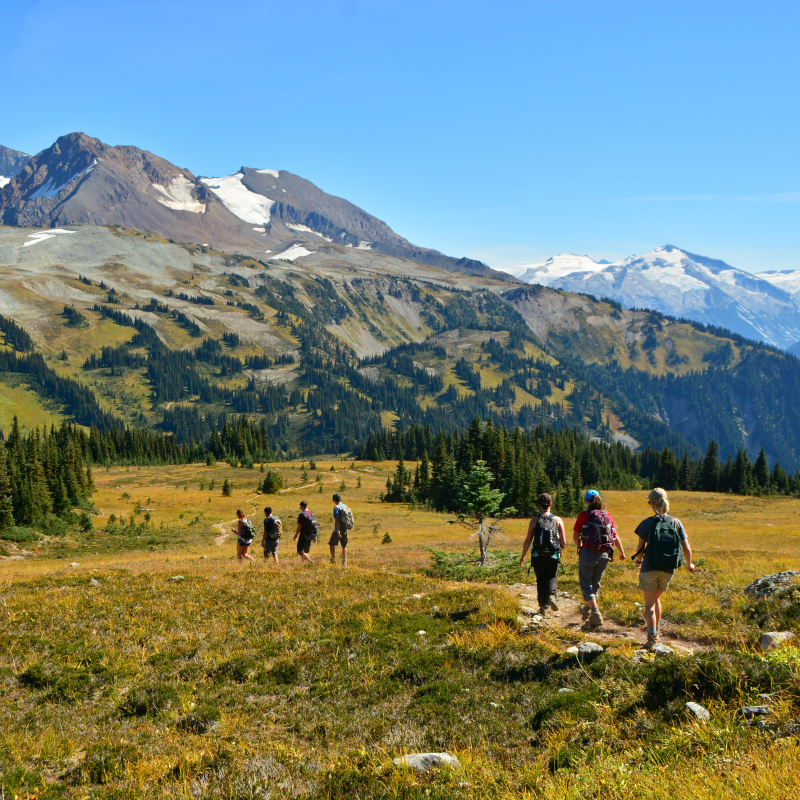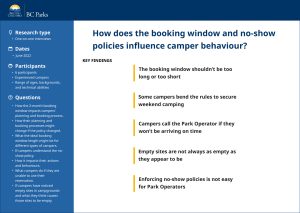Want to learn more about BC Parks visitor data? Click here!
Categories:
Curious about visitor use data at BC Parks? Look no further.
We strive to be effective stewards of parks and protected areas while making them more enjoyable and inclusive for everyone. We continuously make improvements based on visitor experiences and feedback, and we are working to better understand park visitors by improving the way we collect and analyze visitor data.
How do we collect and use visitor use data?
Visitor data is collected through a variety of methods such as trail counters, day-use passes and camping reservation bookings, visual counts, and visitor surveys. The data helps BC Parks create approaches that improve people’s experiences in parks while managing the impacts on habitats and local communities. It helps us allocate resources, plan future services, evaluate performance, and monitor the impacts of visitors.
BC Parks is working to make visitor use data easier to find
We recognize the importance of releasing visitor data to the public, and we are working to make the data easier to find and accessible.
During the past few years, BC Parks has gone through a significant transformation in terms of how visitor data is collected, recorded, and analysed. We have implemented new reservation and attendance systems, launched a day-use pass system, and revamped our Visitor Satisfaction Survey. We are now ready to release a series of reports summarizing the data from all these sources.
In late 2019, we moved to a new camping reservation and attendance data system. The attendance data produced for 2020 and 2021 contained numerous errors and failed to properly report the various types of attendance collected by BC Parks. In 2022, we responded by making further improvements to the reservation service and attendance data collection system, which restored the ability to report attendance data. These issues in 2020 and 2021 leave a permanent gap in our ability to report on visitor data during this period, however, BC Parks has since developed in-house tools and capacity to collect, analyse and report out on attendance and revenue data that will ensure accurate information is publicly available in future years.
Going forward, BC Parks is committed to providing regular reporting of visitor use data.
Because of the complexity of the park system, it takes time to collect, enter, verify, and analyse the data from our various recreation offerings across the province. In this context, we will aim to release this data publicly as soon as it is available.

Links to the reports:
2018/19 – 2023/24 Visitor Attendance Report
This report summarizes annual camping, day use and boating visitation data across select provincial parks and protected areas for the 2018/19, 2019/20, 2022/23, and 2023/24 fiscal years (the fiscal year runs April – March).
2024/25 Interim Visitor Attendance Report
This report contains visitation data for the period of April – September2024. A full 2024/25 Visitor Attendance Report will be released in summer 2025.
2023 BC Parks Visitor Satisfaction Survey – Provincial Summary Report (gov.bc.ca)
This report breaks down visitor satisfaction for provincial parks from June – September 2023, including overall satisfaction, satisfaction with particular amenities and experiences in the park visitor journey, and importance of possible new amenities and services.
2020-23 Day-Use Pass Statistics Summary Report
This report showcases all day-use pass data from July 2020 to March 2023.
2023 Summer Day-Use Pass Statistics Roundup
This report provides a detailed summary of day-use pass reservation data for the 2023 summer season.
2023/24 Winter Day-Use Pass Statistics Roundup
This report provides a detailed summary of day-use pass reservation data from December 2023 to March 2024.
2024 Summer Day-Use Pass Statistics Roundup
This report provides a detailed summary of day-use pass reservation data for the 2024 summer season.
2022 BC Parks Day-Use Pass Public Engagement Summary
This report outlines the results of BC Parks’ 2022 day-use pass engagement, with data collected from nearly 1,000 respondents. The report features both a summary section and a detailed breakdown of responses to each question.




